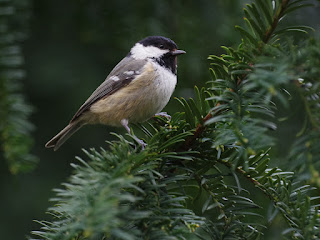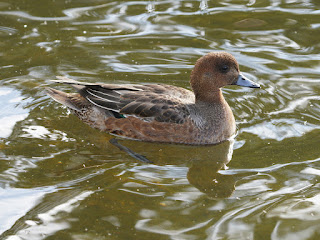An autumn tree beside the Serpentine was heavy with Feral Pigeons, like unappetising grey fruit.
At the bridge, a Blue Tit emerged from a hole in the dead tree. There are many holes in the rotten wood, and Blue Tits nested here in the spring.
The Coal Tit came down several times to be fed ...
... often rudely interrupted by a Great Tit which pushed it away.
Starlings at the Lido restaurant were delighted to find some leftover chips on a table.
The female Peregrine was on the crane, looking up at her mate who was circling too high for a photograph.
The catalpa beans on the tree in the Rose Garden ripen later than those in Kensington Gardens, and the Rose-Ringed Parakeets are busy extracting the seeds. The video shows the messy way these destructive birds do it, wasting much more than they eat.
A look at the fountain in the Rose Garden, topped by a figure of the goddess Diana shooting with her bow. Since there is now a sort of fountain, or at least a water feature, for Princess Diana at the other end of Hyde Park, this is now known as the Huntress Fountain. It has been here since 1906 and was made by Countess Feodora Gleichen, the first woman member of the Royal Society of British Sculptors. Its Art Nouveau style is unusual in Britain. As I was leaving the flow of water was much increased by a heavy shower.
A Cormorant was asleep on a post at the island.
A pair of Egyptian Geese on the Serpentine bobbed their heads in courtship before mating. Like humans, they have no fixed mating season.
The blond Egyptian male was in the same place as before, with his unfaithful mate paired with the aggressive male who has ousted him for the second time. He looked very downcast.
The female Wigeon was working her way round the east end of the lake hoping to be fed as if she had been a park bird all her life.
An interesting picture sent in my someone who prefers to remain anonymous. A female Mandarin was eating an acorn. They must have a ferociously tough gizzard to rasp off the hard shell, and an equally tough digestion to detoxify the tannins in the acorn.
Tom was at Rainham Marshes, and sent a fine picture of a female Kestrel ...
... and another Dartford Warbler -- there seem to be quite a few of these in London now.
I'm going to Rainham tomorrow and hope to see it.











[Blogger ate my comment. Darn]
ReplyDeleteDunno. They look like funny grey christmas tree ornaments to me.
That Wigeon has learned uncommonly fast how to toot for food. Clever girl.
Hope you'll see many Dartford Warblers tomorrow! (or rather, today).
A Feral Christmas tree is not the tree for me. But even one Dartford Warbler will make my day.
DeleteInteresting to see the Mandarin eating the acorn. I know their close relative the Wood Duck, regularly eat these in the US. I've watched Mallard feeding on them too, but they'll eat anything!
ReplyDeleteI think that the tannins can be tolerated by birds as long as acorns don't form more than a small part of their diet. Apparently Jays, which eat a lot of acorns, let the wet soil leach some of the tannins out of buried acorns before eating them.
Delete